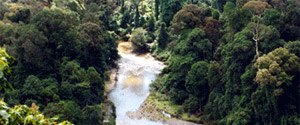|
|
Transoceanic Highway Will Link Amazon to the Pacific
By Rhett Butler
 [citation] [citation]
Brazil and Peru have announced a $700 million plan for a highway that would link Brazil's Amazon river port of Assis to Peru's Pacific ports of Matarini, Ilo and San Juan, raising concerns over further deforestation in the region. Officials say the main purpose of the 711-mile Transoceanic Highway is to enable farmers in the Brazilian Amazon to efficiently bring agricultural products (like soybeans and cattle) to international markets, but environmentalists fear the road will result in increased destruction of the Amazon rainforest.
Roads linked to deforestation in the Amazon
Recent satellite data fuels speculation that this highway project could result in significant deforestation. Last month, the Brazilian government released figures showing nearly 9,000 square miles of the Amazon have been destroyed this year. The satellite data showed a marked increase in deforestation along the BR-163 road, a highway the government has been paving in an effort to help soy farmers from Mato Grosso get their crops to export markets. Critics need point no further than Brazil's ill-fated Trans-Amazonian highway project of the 1970s to support their concerns.
Proposed road would cut through primary rainforest
Environmentalists fear the Transoceanic Highway would have a similar impact -- the latest proposal have the road running through a primary rainforest in the Madre de Dios province before climbing over the Andes and down to the Pacific coast.
More on roads in the Amazon
Roads are enablers of rainforest destruction
 (09/24/2009) Chainsaws, bulldozers, and fires are tools of rainforest destruction, but roads are enablers. Roads link resources to markets, enabling loggers, farmers, ranchers, miners, and land speculators to convert remote forests into economic opportunities. But the ecological cost is high: 95 percent of deforestation in the Brazilian Amazon occurs within 50-kilometers of a road; in Africa, where logging roads are rapidly expanding across the Congo basin, the bulk of bushmeat hunting occurs near roads. In Laos and Sumatra, roads are opening last remnants of intact forests to logging, poaching, and plantation development. But roads also cause subtler impacts, fragmenting habitats, altering microclimates, creating highways for invasive species, blocking movement of wildlife, and claiming animals as roadkill. A new paper, published in Trends in Evolution and Ecology, reviews these and other impacts of roads on rainforests. Its conclusions don't bode well for the future of forests.
(09/24/2009) Chainsaws, bulldozers, and fires are tools of rainforest destruction, but roads are enablers. Roads link resources to markets, enabling loggers, farmers, ranchers, miners, and land speculators to convert remote forests into economic opportunities. But the ecological cost is high: 95 percent of deforestation in the Brazilian Amazon occurs within 50-kilometers of a road; in Africa, where logging roads are rapidly expanding across the Congo basin, the bulk of bushmeat hunting occurs near roads. In Laos and Sumatra, roads are opening last remnants of intact forests to logging, poaching, and plantation development. But roads also cause subtler impacts, fragmenting habitats, altering microclimates, creating highways for invasive species, blocking movement of wildlife, and claiming animals as roadkill. A new paper, published in Trends in Evolution and Ecology, reviews these and other impacts of roads on rainforests. Its conclusions don't bode well for the future of forests.
Oil road transforms indigenous nomadic hunters into commercial poachers in the Ecuadorian Amazon
 (09/13/2009) The documentary Crude opened this weekend in New York, while the film shows the direct impact of the oil industry on indigenous groups a new study proves that the presence of oil companies can have subtler, but still major impacts, on indigenous groups and the ecosystems in which they live. In Ecuador's Yasuni National Park—comprising 982,000 hectares of what the researchers call "one of the most species diverse forests in the world"—the presence of an oil company has disrupted the lives of the Waorani and the Kichwa peoples, and the rich abundance of wildlife living within the forest.
(09/13/2009) The documentary Crude opened this weekend in New York, while the film shows the direct impact of the oil industry on indigenous groups a new study proves that the presence of oil companies can have subtler, but still major impacts, on indigenous groups and the ecosystems in which they live. In Ecuador's Yasuni National Park—comprising 982,000 hectares of what the researchers call "one of the most species diverse forests in the world"—the presence of an oil company has disrupted the lives of the Waorani and the Kichwa peoples, and the rich abundance of wildlife living within the forest.
New legislation in Brazil opens up road-paving across country, threatening Amazon
(04/21/2009) Brazil’s Chamber of Deputies has approved a measure that would speed up paving roads across the country, including paving a road that environmentalists have long-fought, BR-319. Environmental groups across the nation have warned of widespread deforestation if the measure passes the Senate and is signed by the president.
Peru fails to investigate murder of Amazon environmental leader
(04/22/2008) Peruvian authorities failed to respond to requests for protection from Julio Garcia Agapito, the environmental leader who was gunned down in southeastern Peru in late February, according to a new petition which calls for an investigation into his murder. Julio Garcia's killing at the hands of an illegal logger set off international outcry and highlighted rising tensions over the paving of a highway in the Amazon rainforest.
Railroad could reduce Amazon deforestation relative to proposed highway
(03/24/2008) Building a railroad instead of improving a major highway could reduce deforestation and biodiversity loss in the heart of the Amazon rainforest says an Brazilian environmental group.
Amazon environmentalist gunned down in Peru
(03/14/2008) After reporting a truck loaded with mahogany illegally logged from the Amazon rainforest, Don Julio Garcia Agapito, a Peruvian environmentalist was gunned down by unknown assailants on February 26th, 2008. He is survived by his family.
Industry-driven road-building to fuel Amazon deforestation
(03/12/2008) Unofficial road-building will be a major driver of deforestation and land-use change in the Amazon rainforest, according to an analysis published in Philosophical Transactions of the Royal Society B. Improved governance, as exemplified by the innovative MAP Initiative in the southwestern Amazon, could help reduce the future impact of roads, without diminishing economic prospects in the region.
Toll road could raise money for Amazon conservation
(07/15/2007) Southeastern Peru is arguably the most biodiverse place on the planet. A new highway project, already under construction, poses a great threat to this biological richness as well as indigenous groups that live in the region. While its too late to stop the road, called the Carretera Transoceanica or Interoceanic Highway, there are ways to reduce its impact on the forest ecosystem and its inhabitants.
Selective logging leads to clear-cutting in the Amazon rainforest
(07/31/2006) A new study links selective logging to clear-cutting in the Amazon rainforest. The research is significant because it identifies an important indicator of rain forest vulnerability to clear-cutting in Brazil.
Chinese economy drives road-building and deforestation in the Amazon
The state of Madre de Dios in southeastern Peru is home to mountainous cloud forests and low-lying rainforests containing the richest biodiversity on Earth. It may also soon be home to a transcontinental highway. If all goes according to plan and schedule, by June 2006, there will be an asphalt road connecting Sao Paulo to Lima, and more importantly, the Pacific Peruvian ports of Matarini, Ilo and San Juan. The east-west Carretera Transoceanica -- "transoceanic highway" -- as the project is called, is viewed as a long-awaited and close to finalized dream for proponents, namely the Peruvian and Brazilian governments, agricultural groups and local residents, and as a nightmare for environmentalists.
|
To learn more about deforestation in the Amazon, check out these links:
THE AMAZON RAINFOREST
|
|
For kids
Multi-media
|
|
|
|
|
THE AMAZON
ADVERTISEMENT
KEY ARTICLES
RAINFORESTS

ADVERTISEMENT
FOR KIDS

MONGABAY.COM


Share
|